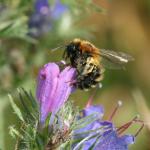Melitta nigriceps Kirby, 1802, Melitta lanifrons Kirby, 1802, Andrena jagnobensis Morawitz, 1894, Andrena nigriceps var hispanica Friese, 1922, Andrena nigriceps pamirensis Alfken, 1931, Andrena marchica Alfken, 1939, Andrena nigriceps comata Warncke, 1974
A medium-sized, well-haired mining bee, the female of which has a distinctive banded appearance to the gaster, these bands being made up of paler hairs. It has jet-black facial hairs, which set it apart from females of its close relatives, A. denticulata (Kirby), fuscipes (Kirby), simillima Smith and tridentata (Kirby). Males have a thickened ridge behind the eyes and ocelli. As in most other members of this group, males are much less frequently seen than females.
Known throughout England, south Wales and southern Scotland. It also occurs in the Channel Islands. It is always a scarce and very local bee.
Overseas, found in Europe (but scarce in Fennoscandia), to central eastern Asia.
Listed as Notable B in Falk (1991) (now known as Nationally Scarce Nb).
Associated with flowery grasslands on lighter soils.
Univoltine; July to September.
Nests singly in short turf or bare ground.
Recorded as visiting a wide range of later summer-flowering plants.
Nomada rufipes Fabricius is recorded as being associated with A. nigriceps, in common with other members of this group of Andrena.
2012


